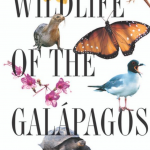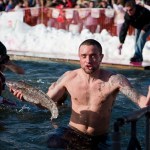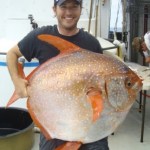fish
Image of cave dwelling Mexican tetra By Citron via Wikimedia Commons
Mexican tetra (Astyanax mexicanus) are a fascinating example of divergent evolution. Over time, some of these freshwater river fish washed into caves where they continue to live. With perpetual darkness, these cavefish have lost their ability to see along with their skin pigmentation. Oxygen and food are also hard to come by in the caves. In fact, the cave dwelling fish may go for months without eating as they wait for seasonal floods to deliver foods. Dr. Cliff Tabin (Harvard Medical School) recently presented his…
Image of yellowfin tuna via Wikimedia Commons.
I love fishing. As with every fisherman, I have my fair share of "the one that got away" stories steeped in *mostly* truth. So, you can imagine my interest in reading research that shows fish appear to be shrinking in warming waters.
Warm waters carry less oxygen, which makes it difficult for fish to breath...especially larger fish. Metabolism is also higher in fish living in warm waters. Higher metabolism means the fish need more oxygen. The gills of fish are responsible for extracting oxygen from water and when they reach their maximum…
Samples of fish species from the Poeciliidae family show the diversity in color, fin size and body shape. Kansas State University researchers studied 112 species of these live-bearing fishes and found that males and females evolve differently. Image courtesy of Kansas State University
Dr. Michael Tobler and Dr. Zach Culumber at Kansas State University examined 112 species of live-bearing fish (Poeciliidae) and have made some interesting discoveries about their evolution. Their analyses included information on body shape, fin size, where the species are found and information on…
Photo of zebrafish housed at a research institute. By Karol Głąb CC BY-SA 3.0. via Wikimedia Commons
Who would have thought tiny fish could lead to big advances in medicine? Zebrafish (Danio rerio) and mammals have similar anatomy and physiology of the brain, eyes, gut, and cardiovascular systems. Some of the reasons why these fish are good models to understand cardiovascular physiology were recently explored in a new article published in Physiological Reviews.
Animal models are used in research that seeks to understand both normal physiological mechanisms as well as mechanisms…
Photo of zebrafish (Danio rerio) by Azul (Own work) [Copyrighted free use], via Wikimedia Commons
We all know that aerobic exercise is good for us because it helps improve muscle function and our ability to move well. For fish, aerobic exercise helps animals escape predators, catch prey as well as improve reproduction success. When we exercise, our muscles adapt by altering the metabolism of energy, the way calcium is handled as well as the type of contractile proteins present in the muscle. Together these changes alter how muscles contract. Histone deacetylases (HDAC) are…
Image of a gilthead sea bream by Roberto Pillon - via Wikimedia Commons
Similar to humans, muscle growth in fish is increased with exercise. Unlike humans, however, teleost fish are able to continue growing in length as well as weight throughout their lives. This type of meat, I mean muscle, growth happens in two ways: 1) muscle cells get bigger and 2) new muscle cells form. Researchers at the University of Barcelona in Spain wanted to know what effect moderate sustained swimming would have on the muscles of young fingerling gilthead sea bream, a type of…
Image of zebrafish By Pogrebnoj-Alexandroff from Wikimedia Commons
We tend to think of carbon monoxide (CO) only in terms of being a poisonous gas. The reason for its toxicity is due to its ability to bind really tightly to our hemoglobin molecules, which prevents oxygen from being able to bind. In mammals, CO also decrease breathing rate. As you can imagine, it is a pretty terrible gas to breath in when you are a species dependent on hemoglobin for delivery of oxygen to tissues.
Did you know that CO is also produced in our bodies when heme molecules are broken down by…
There aren't any. But, aquaria have many times tried to make it so, and it always goes bad for the shark. The basic problem is that great white sharks are pelagic, and it is very hard to keep pelagic creatures in a confined space, and the largest aquaria are very confined from the point of view of a large pelagic animal.
Another problem would eventually become important in the event that an aquarium managed to keep a great white shark alive long enough. When they are young, great white sharks dine on fish. When they are adults, they seem to prefer mammals. So, imagine feeding time at the…
Image of a Gulf toadfish, Opsanus beta, from Wikimedia Commons
Teleost fish living in saltwater environments are constantly compensating for water loss. This happens because their surroundings have higher concentrations of salts than their plasma and the rule of thumb in Biology is: water follows salt. Thus these fish must somehow compensate for water loss in order to prevent dehydration. One way they do this is by drinking a lot of water. Ions are then removed from the water in the intestines which creates a gradient for water absorption into the body. A new…
Image of elephant fish by fir0002 | flagstaffotos.com.au Canon 20D + Tamron 28-75mm f/2.8 - Own work, GFDL 1.2, https://commons.wikimedia.org/w/index.php?curid=864471
Seawater contains sulfate concentrations that are nearly 40 times those measured in plasma. Therefore, it is easy to see why fish would need to develop mechanisms to keep sulfate within a physiologically normal range. The kidneys of teleost fish have been known to excrete excess sulfate in the urine. However until now, it was not known whether the kidneys of cartilaginous fish do the same thing as their…
Still going strong...here are the highlights from several sessions held on Day 4:
Drawing of Lake Whitefish by William Converse Kendall - Kendall, William Converse, b. (1909) Fishes of the Connecticut Lakes and Neighboring Waters, with Notes on the Plankton Environment, Report of the Commissioner of Fisheries, 1906-1907, Washington, DC: Government Printing Office, p. 39 Fig.1, Public Domain
John Eme (California State University, San Marcos) presented data testing the effects of varying temperatures mimicking overwintering conditions on embryonic development of Lake whitefish. He…
A special thank you to reader Dr. Barbara Goodman, Professor of Physiology at Sanford School of Medicine of the University of South Dakota who sent me a story from The Scientist about sleep in animals complete with footage of a dolphin that was seen apparently "sleeping" (video posted on YouTube):
Why do animals sleep? This is a question with many potential answers. It is known that birds and mammals experience slow-wave and rapid eye movement (REM) sleep patterns. During the first pattern, slow waves with high amplitudes can be seen if measuring electrical…
Wildlife of the Galápagos: Second Edition (Princeton Pocket Guides), by Julian Fitter, Daniel Fitter, and David Hosking is both a field guide and a travel guide, focusing on the Galapagos Islands. It includes basic information about each island and each town or tourist destination, and a comprehensive guide to how to visit, what to bring and not bring, and otherwise plan your trip to these amazing evolution-drenched islands.
The wildlife that is covered includes birds, other land vertebrates including the famous tortoises and lizards, offshore mammals, fish, insects, and plants. There is…
Image of gilthead sea bream By Roberto Pillon - http://www.fishbase.us/photos/UploadedBy.php?autoctr=13070&win=uploaded, CC BY 3.0, https://commons.wikimedia.org/w/index.php?curid=20825139
A new study published in the American Journal of Physiology - Regulatory, Integrative and Comparative Physiology explored the effects of exercise on growth and hormone regulation in gilthead sea bream (Sparus aurata). The main hormones that regulate growth are, perhaps not surprisingly, growth hormone and insulin-like growth factor. Researchers discovered young gilthead seam bream that underwent…
Left Top: Pacific hatchetfish; Left Bottom: longfin lanternfish; Right: an acoustic instrument in the Pacific Ocean. (Images from Scripps Institution of Oceanography press release)
I love a good mystery. This one has puzzled scientists for several years now...ever since they discovered a humming or buzzing noise in the Pacific ocean, an otherwise rather quiet place. This was no ordinary noise, that they knew of. In a recent interview on NPR, Dr. Simone Baumann-Pickering, Scripps Institution of Oceanography (La Jolla, California) shared what she and her team think is causing all that noise…
Over the last several years, ice fishing contests, which are a big deal in Minnesota, have been repeatedly cancelled due to insufficient ice thickness on the relevant lake. Some of these contests have been permanently cancelled because the annual cancelations were becoming more frequent. Just now, the Maple Lake Ice Fishing Derby has been cancelled. That's bad.
But even more disturbing is this:
Ice conditions for the Eel Pout Festival have created enough concern to prompt vehicle restrictions, according to the Cass County Sheriff’s Office.
Sheriff Tom Burch says vehicle traffic on Walker…
Nick Wegner (Southwest Fisheries Science Center) is pictured here holding an opah. Image Credit: NOAA Fisheries, Southwest Fisheries Science Center
The opah (Lampris guttatus), otherwise known as a moonfish, lives in the deep sea where warm blood can be advantageous. According to a quote from Nicholas Wegner (NOAA) posted in Live Science, "Increased temperature speeds up physiological processes within the bod. As a result, the muscles can contract faster, the temporal resolution of the eye is increased, and neurological transmissions are sped up. This results in faster swimming speeds…
Yesterday (Tuesday) was another great day for Comparative Physiology!
Congratulations to Dr. Arthur DeVries (above; Professor Emeritus, Department of Molecular and Integrative Physiology; Professor of Animal Biology, University of Illinois), this year's recipient of the August Krogh Distinguished lecturer award from the Comparative and Evolutionary Physiology section of the American Physiological Society. Dr. DeVries gave an excellent seminar summarizing his career studying fish that live in some of the coldest waters without freezing! The fish accomplish this amazing task by having anti-…
Pictoral abstract showing the use of nanofibers from fish collagen in wound healing. Image from Zhou et al., 2015.
Researchers in China have discovered that collagen isolated from the skin of tilapia effectively reduce wound healing time in mice. The usefulness of collagen, a major structural protein found in connective tussues, in wound healing has been known. Using fish proteins instead of typical mammalian sources reduces the risk for potential pathogens.
Dr. Jiao Sun (Shanghai Jiaotong University School of Medicine) and colleagues isolated collagen from the skin of tilapia and…
Greg Laden reports on a hominid fossil "recovered from the seabed near Taiwan" which reveals new levels of dental diversity among proto-humans and may qualify as a new species. Greg says the specimen known as Penghu "is yet another indicator that multiple different hominids lived on the Earth at the same time after the rise of Homo erectus." But why was it located underwater? In another example of what lies beneath, Dr. Dolittle marvels at "an unexpected find and very exciting moment for researchers;" the discovery of small fish and invertebrates thriving below 740 meters of ice near the…



